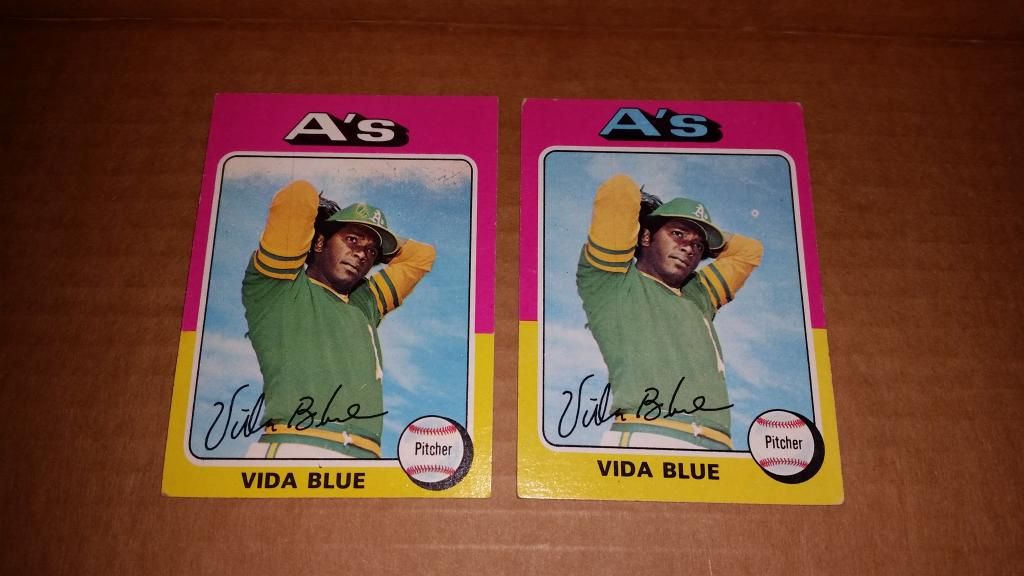Is this 1975 Topps card a known variation?
I was going through a bunch of 1975 Topps and noticed something very interesting. This Vida Blue card looks like a variation. The team name at the top is white instead of light blue. I looked at all of the cards on eBay and could not find this variation. Have any of you seen this card or one like it?


Shane
0
Comments
Currently collecting 1934 Butterfinger, 1969 Nabisco, 1991 Topps Desert Shield (in PSA 9 or 10), and 1990 Donruss Learning Series (in PSA 10).
I've never heard of this variation.
Thanks,
David (LD_Ferg)
1985 Topps Football (starting in psa 8) - #9 - started 05/21/06
As a former printer, that was my thought. The thing that would be interesting to know, is where is Vida Blue's card in the sheet. Printing presses usually start loosing ink in the middle of the roller, because ink has a tendency to collect at the end of the rollers. What is odd is the that the blue appears darker on the card on the left at the Blue's right shoulder than on the card on the right.
Currently collecting 1934 Butterfinger, 1969 Nabisco, 1991 Topps Desert Shield (in PSA 9 or 10), and 1990 Donruss Learning Series (in PSA 10).
<< <i>Ironic that Vida is missing some blue >>
Nice!
Interesting to see this unique piece.
Doug
Liquidating my collection for the 3rd and final time. Time for others to enjoy what I have enjoyed over the last several decades. Money could be put to better use.
Bowman Baseball -1948-1955
Fleer Baseball-1923, 1959-2007
Al
Collecting 1970s Topps baseball wax, rack and cello packs, as well as PCGS graded Half Cents, Large Cents, Two Cent pieces and Three Cent Silver pieces.
Vida Blue is the first card in the middle row (row 6 of 12). See the third sheet in the image below.
Bowman Baseball -1948-1955
Fleer Baseball-1923, 1959-2007
Al
<< <i>While it would not make my list as a variation as opposed to a variant, what pray tell is the official hobby definition of a variation ?
Personally, I think many are quick to declare variations for quality control issues. Just because some ink is missing or lighter than usual should not classify as a variant. To me, a true variation that is uniform across a known quantity of examples of cards such as 1982 Topps blackless. We already see too many claims for name in yellow in 1980 Topps when half the name is still red, lol.
Collecting 1970s Topps baseball wax, rack and cello packs, as well as PCGS graded Half Cents, Large Cents, Two Cent pieces and Three Cent Silver pieces.
But as far as I know there is no recognized hobby definition of a "true" variation. The 57 Bakep, the 58 Herrer, the 61 Fairly are all recognized in the hobby as variations, even though they too are just recurring print defects. In my view, what is or is not a variation in the hobby is at the whim of catalog editors and PSA graders.
I collect any interesting variants, which for me are cards different from their common counterparts in some way, sometimes recurring and sometimes not. But value is determined by hobby recognition
Bowman Baseball -1948-1955
Fleer Baseball-1923, 1959-2007
Al
Another example
Bowman Baseball -1948-1955
Fleer Baseball-1923, 1959-2007
Al
[
Another example
Bowman Baseball -1948-1955
Fleer Baseball-1923, 1959-2007
Al
Shane
<< <i>At some point, how interesting the variation is becomes the primary issue. I've seen 30 of the same card with the same print dot in the same place. Does that make it a recurring variation? Either way, it's something almost no one would care about, so the point is moot. >>
Agreed.
Collecting 1970s Topps baseball wax, rack and cello packs, as well as PCGS graded Half Cents, Large Cents, Two Cent pieces and Three Cent Silver pieces.
<< <i>
<< <i>At some point, how interesting the variation is becomes the primary issue. I've seen 30 of the same card with the same print dot in the same place. Does that make it a recurring variation? Either way, it's something almost no one would care about, so the point is moot. >>
Agreed. >>
I agree with that as well. If this card would have been a 1975 Topps George Brett, Nolan Ryan, or Hank Aaron, it would make it much more interesting and unique. Vida Blue...not so much.
Shane
<< <i>If that Vida Blue card were a coin, it would be off the charts valuable. The mint is infinitely more scrupulous about making sure errors don't leave the building. >>
Depends on the error and the coin. Some common errors like offstruck coins are fairly common. Others like the 1955 cent with DDO are very valuable indeed.
Collecting 1970s Topps baseball wax, rack and cello packs, as well as PCGS graded Half Cents, Large Cents, Two Cent pieces and Three Cent Silver pieces.